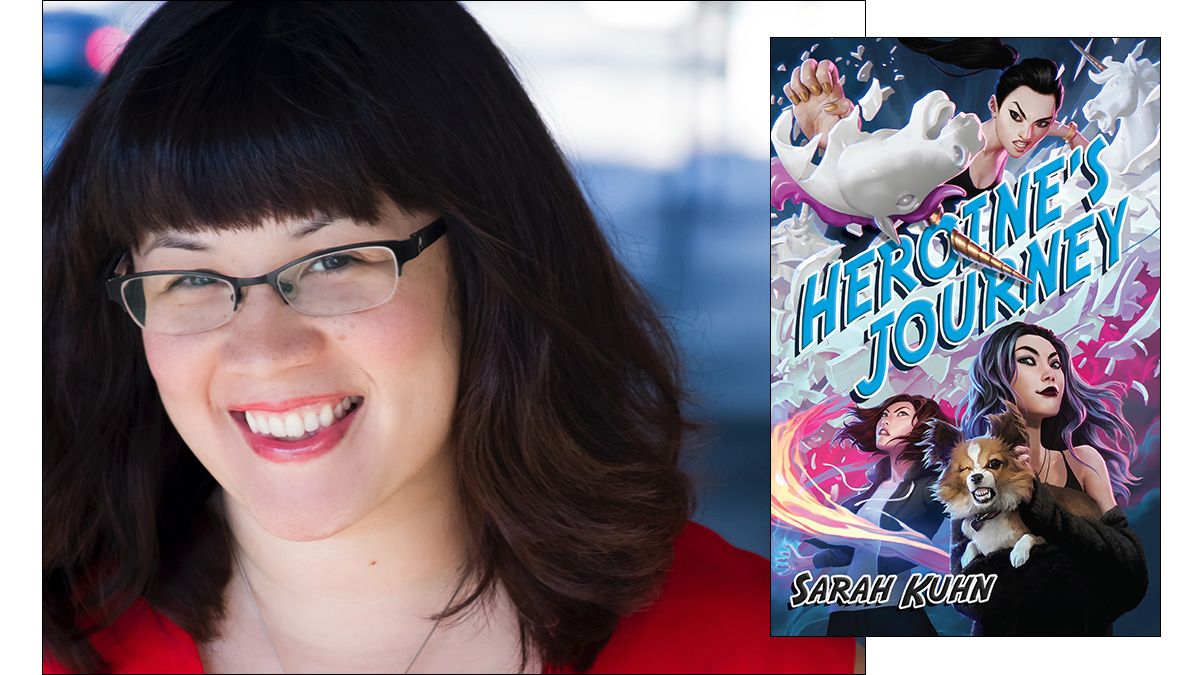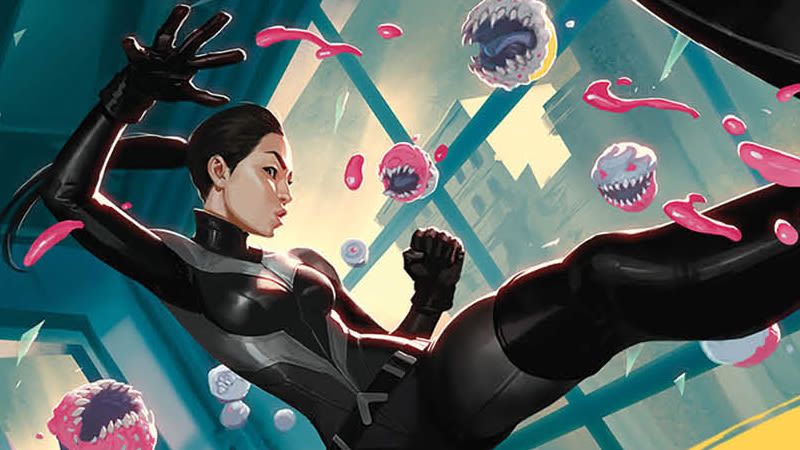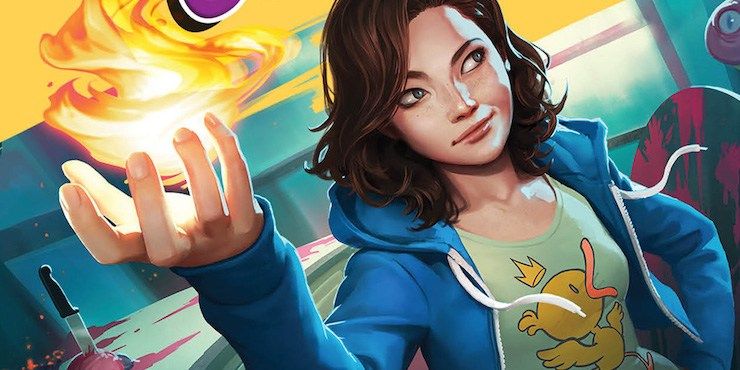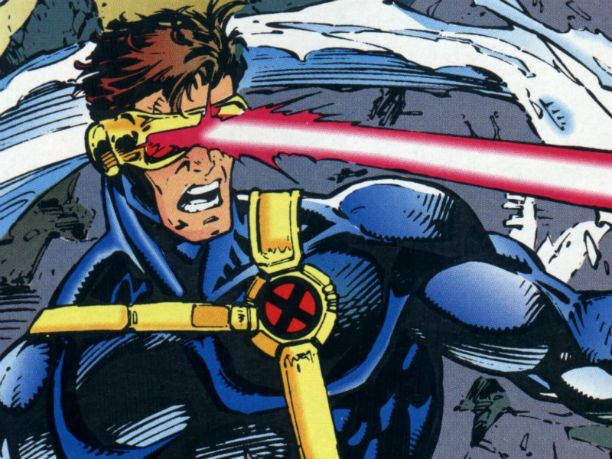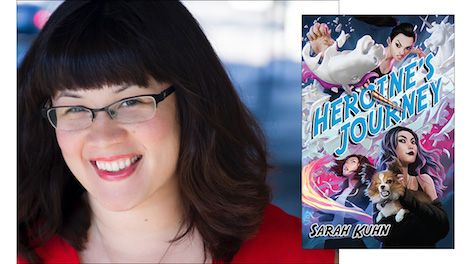
Sarah Kuhn Talks Superheroines, Princess Leia’s Downtime, and Pon Farr Prompts
Guys. I got to talk to Sarah Kuhn, Campbell finalist and author of One Con Glory and Heroine’s Journey during San Diego Comic Con.
That is all.
Nah, I’m just kidding. Here you go:
BR: Do you remember when you first started telling your own stories?
SK: In a way, most writers are always telling stories… I used to tell a lot of stories about Princess Leia and what she was doing on her downtime since they never seemed to show that part in Star Wars. I was very interested… she always showed up looking so amazing… in Return of the Jedi, I just assumed the Ewoks did it. In Cloud City? That was very elaborate, it must have taken a lot of time… As far as my own stories, I think it took a while for a lot of reasons. When I was growing up, I had a very typical Japanese-American tiger mom and whenever I talked about doing anything creative, anything impractical, as an occupation, she would say, “Okay, but you also need health insurance….” Someone said to me at one point, “You know, if you become a journalist, you get paid every day to write… and maybe you get health insurance.” That was my way of being a writer and still satisfying my mother’s worry about me. I was kind of scared to try writing anything that wasn’t someone else’s story. Journalism offers you so many great opportunities to be creative and shape different stories and tell stories that need to be told but at the end of the day, I was more comfortable with it because I was always talking about someone else… I guess it started with One Con Glory, which was my little serialized novella. My friends and I were doing an online zine… every month we were going to do a prompt and that month’s prompt was, “Pon Farr.” My idea was, “So what if this person who, for whatever reason, hasn’t had sex in seven years… and in her case, there’s something behind it. It kind of grew from there. I also had this idea… whenever I saw saw nerd girls in stories, they were always prizes or the girl who was wearing glasses and a bun and takes her hair down and is a supermodel. It was always very male gaze-y… I felt that I and other girls I knew who liked comic books… it wasn’t about making ourselves attractive to men. It was what we liked and we could fight about X-Men continuity just as long as they could. I wanted to create a character who was like that: aggressive and set in her opinions about geek franchises. To me, that was more realistic.
BR: At this point, you’ve done a novella, a series of adult novels, comics, and now you have a YA romantic comedy coming out next year. Do you have a different process for each of them?
SK: My process for each is different. Even my process for each of the three Heroines (Heroine Complex, Heroine Worship, and Heroine’s Journey) was different… I love the collaborative aspect of comics… Writing a prose novel, at the end of the day, is very solitary…. I do have a loosely structured writing group called “The Shamers…” The idea was to get together at a coffee shop and shame each other into writing…
BR: Something I’ve notice in the Heroine novels is that the boys are important characters but it’s really the female relationships that are front and center, something we don’t see a lot in superhero stories. Was there something that signaled to you it was time for that to happen?
SK: Some of my favorite parts of superhero stories, that are sometimes in the margins or off to the side, are those mundane friendship moments. One of my favorite issues of X-Men is the issue with Jubilee’s first appearance; there’s a ladies night where they all go to the mall together and go shoe shopping and to this weird, pseudo-Chip n’ Dale’s show. They’re all embarassing Storm and they all get their hair done. There’s supernatural hijinx and things they have to solve as superheroines, but I like that there’s this issue about bonding and what they do on their day off…. And if you are a fabulous superheroine, who does all the grunt work? Who works gets your costume cleaned and works on your social media presence? Unless it’s part of your power, you don’t just appear somewhere looking amazing and perfect and then kick ass and go home. There are things that happen in between… I wanted to explore that a little bit more… I have deep complicated, sister-like relationships with my female friends and I wanted to see it in this sort of ridiculous, supernatural setting where there are things like demons.
BR: Historically, people haven’t had a chance to see a lot of Asian superheroes and when they have been presented, it’s been as a sort of cultural monolith,which is obviously BS. Talk a little bit about how you went about busting that up.
SK: I think that’s kind of how you approach characters in general. Specificity. Someone’s identity isn’t their whole life but it certainly affects their life. It affects them every day in ways that are big and small. I think we’re used to talking about the big ways… all the tragedy and struggle that especially women of color have to face. I think that looking at it with specificity, looking at the little ways, like the lunch box moment in the first book, where these two girls bond because they both bring in a snack their classmates think is weird… I think that’s a moment a lot of kids of color have and it’s something that can bond someone to you for life if you’re the only other one. One of my best friends growing up was the one other mixed Asian girl in my class who was half Indonesian. It was like that episode of Fresh Off The Boat where they see the Chinese family from the bus… you have a lot of those experiences in common. I think also, what’s sort of interesting to me now, is when I started writing the first book, I wasn’t necessarily coming to it from an empowered place; I mean yes, badass, Asian superherones but when I wrote One Con Glory, I remember having the thought process of, “Here’s this character, she’s a nerd, she’s just like me, and we’re going to put her in this rom-com situation.” I had a moment where I thought, “Should I make her me? Should I give her my identity as well?” I fell into that trap, that self-rejection that’s happened to a lot of us because, I thought, “Then the whole story has to be about her being Asian,” which now is so sad to me. When the novella started getting some traction… a lot of people assumed she was Asian anyway because I wrote her. I thought, “Well, if that’s going to happen anyway, I may as well make this character my exact racial identity and give her some friends.” I have a lot of friends who are lots of kinds of Asian-American and I wanted to reflect that diversity but then… once I started getting into to it, I realized it felt fun and empowering and it felt so special because it is these girls, who look like me, who look like so many of my friends, who are having adventures I grew up loving but never really saw myself in because we were off to the side if we existed at all.
BR: Readers are always curious about the books authors we talk to are enjoying. What are you enjoying right now?
SK: Oh, I enjoy a lot of things. I love romance, I love fantasy, I love all kinds of YA. I loved The Way You Make Me Feel by Maureen Goo, a contemporary YA rom-com about a girl who pulls a terrible prank and as the price, has to spend the summer working on her dad’s food truck. It’s… delightful and fun… a lot of deep feels, such a wonderful story and such an LA story. The Kiss Quotient by Helen Hoang… is about a woman who identifies on the Autism spectrum… she hires a male escort to help her figure out how to date and have a relationship and have sex… it’s so sweet… it has this combination of sweet and earnest and the characters are so wonderful, you keep thinking about them after but it’s also so sexy… and it has a delightful voice. Appropriate for this convention, a great book called Ship It by Britta Lundin, another YA rom-com, about a girl who is obsessed with a certain TV show and she writes fan fiction for it, lives in a really small town, feels like no one understands her, and then she gets a chance to go to a convention where the cast is appearing. A lot of hijinx ensue. I feel like it’s really a love letter to fandom and geekdom and fan fiction and also really gets at this deeper thing people don’t talk about as much with fan fiction, where sometimes the reason you’re attracted to a certain fandom, or the reason you write a certain fan fiction, is because there’s something in yourself you’re a little bit scared of. It resonates deeply with you but you don’t know why and that’s a good way to process it, connecting with these stories and writing fan fiction. It’s a way to figure all of that out.
BR: You have a tradition of displaying other authors’ books at your launches. When did you start doing that?
SK: With Heroine Complex, my friends Senan McGuire and Amber Benson were nice enough to say, “Lets go on a tour together for your debut.” It meant the world because they brought in their audiences and we had so much fun and it was such a lovely way to support each other. It also lets you have those moments as an author that aren’t as lonely. I don’t know what made me think of it, but for Heroine’s Journey… I was having the party at the Ripped Bodice, which is the only all Romance book store in North America and I thought about… how my books were successful because of people I know from all these aspects of my life… why not do something that celebrates the idea of community? I also wanted to champion different works by women of color, especially in my genres, Romance and Fantasy, because I think sometimes the stories that get the most attention about women of color are the ones that are about “the struggle.” We definitely need those stories but I also want to shine a light on my fellow authors who are writing about women of color having fun.
BR: Okay, two more. Do you remember who your first comics crush was? Mine was Gambit, I remember it very distinctly.
SK: In comics, it was probably Cyclops. There’s something about that uptight, repressed, really buttoned-up guy who actually has all these raging emotions underneath that is super appealing to me. It’s like catnip… In movies, one of my gateways into comics were the old Superman movies with Christopher Reeve and Margot Kidder. I may have had a bigger love for Margot Kidder because she was a badass and I wanted to be Lois Lane who was demanding cheeseburgers at nine in the morning. That seemed like my ideal lifestyle.
BR: I always ask this because I’m a Star Wars nerd. What color would your light saber be?
SK: In my geek girl gang, there’s a split between the people who are definitely dark side and definitely light side. Somehow we all get along. I’m sort of on the border because I will buy the “Rebel” t-shirt but I will also buy the dark side cape. If I were in the Star Wars universe, I’d want to be the first person to have a pink lightsaber.
Sarah is as fabulous, geeky, and lovely as you’d think. Her next book, the YA rom-com, I Love You So Mochi, is due out in June 2019. During SDCC, DC announced Sarah will be writing a Cassandra Cain (Batwoman) graphic novel for the new DC Ink YA imprint. More details on that as they emerge.



